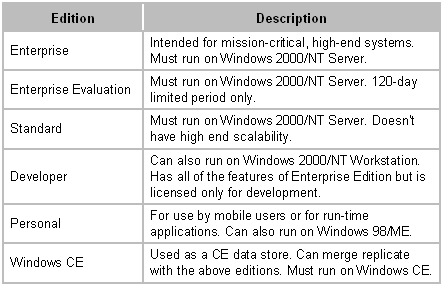Topics covered in this Tutorial
A D V E R T I S E M E N T
- Pre-installation check-list
- Installing SQL Server
- SQL Server components
- Upgrading and compatibility Issues
- Service packs
SQL Server Editions
Microsoft SQL Server 2000 comes in 6 different editions. They are listed below:

Pre-Installation Check list
Before installing
Before installing Microsoft SQL Server 2000 you are recommended to go through
the following check-list.
- Backup your previous Microsoft SQL Server versions if you are installing
SQL Server 2000 on the same computer.
- Shut down all services dependent on SQL Server.
- Shut down Microsoft Windows NT Event Viewer and Regedt32.exe.
- Review the hardware and software requirements for installing SQL Server.
- It is recommended to set up a special account for MSSQLServer and
SQLServerAgent services. This account should be in the server's
Administrators group.
The account should have the following attributes:
- The account must be a member of the Administrators group.
- The account should have the Password Never Expires attribute.
- Log on as a service
- The account should have Log on as a service rights set on the SQL
Server computer and have all logon hours allowed.
- Log on to the system under a user account that has administrative
privileges.
Note: Although you should take care in choosing a
collation for the installation before starting. This is not as critical to
get right in this release as in previous ones because you can now create
databases with different collations.
Install Microsoft SQL Server 2000
Setup Program
Simply placing the Microsoft SQL Server 2000 CD in the CD drive will display a
screen prompting you to install Microsoft SQL Server 2000.

Choosing Install SQL Server 2000 components will load the installation
wizard which will take you through the steps needed for the installation.
Named and multiple instances of SQL server
SQL Server 2000 now supports multiple installed instances. This means you can
install and run up to 16 instances of SQL Server simultaneously on the same
server.
Default instances
A default instance is the name of a computer on which it is running. One default
instance is permitted. Existing 6.5 and 7.0 installations will operate as
default installations.
Named instances
Other instances must be named in the format COMPUTER NAME\INSTANCE (e.g.
CTS\MYSERVER).
SQL server collations and sort rules
SQL Server requires that you define a collation and sort order
which affects character data only.
As in previous releases you cannot change the server's collation and sort order
but you can now create new databases with different collations.
For instance in the example below a database is being created using the
Lithuanian character set with a case-insensitive, accent-insensitive collation.

In this example CI stands for Case-insensitive and AI for
Accent Insensitive. To get a full listing of the collation names and
their meanings run the following query:
Select *
From ::fn_helpcollations()
